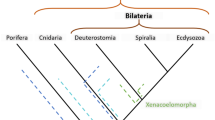Abstract
I attempt to raise questions regarding elements of systematics—primarily in the realm of phylogenetic reconstruction—in order to provoke discussion on the current state of affairs in this discipline, and also evolutionary biology in general: e.g., conceptions of homology and homoplasy, hypothesis testing, the nature of and objections to Hennigian “phylogenetic systematics”, and the schism between (neo)Darwinian descendants of the “modern evolutionary synthesis” and their supposed antagonists, cladists and punctuationalists.
Similar content being viewed by others
References
Ast G (2005) The alternative genome. Sci Am 292(April):59–65
Bateson W (1894) Materials for the study of variation, treated with especial regard to discontinuity in the origin of species. Macmillan, New York
Cain AJ, Harisson GA (1960) Phyletic weighting. Proc Zool Soc Lond 131:1–31
Charlesworth B, Lande R, Slatkin M (1982) A neo-Darwinian commentary on macroevolution. Evol Int J Org Evol 36:474–498. doi:10.2307/2408095
Duboule D, Dollé P (1989) The structural and functional organization of the murine HOX gene family resembles that of Drosophila homeotic genes. EMBO 8:1497–1505
Eldredge N, Gould SJ (1972) Punctuated equilibria: an alternative to phyletic gradualism. In: Schopf TJM (ed) Models in paleobiology. Freeman, Cooper & Co., San Francisco
Fisher RA (1930) The genetical theory of natural selection. Oxford University Press, Oxford
Gerhart J, Kirschner M (1997) Cells, embryos, and evolution: toward a cellular and developmental understanding of phenotypic variation and evolutionary adaptability. Blackwell, Malden
Gould SJ, Eldredge N (1977) Punctuated equilibria: the tempo and mode of evolution reconsidered. Paleobiology 3:115–151
Gould SJ, Vrba ES (1982) Exaptation—a missing term in science of form. Paleobiology 8:581–598
Haldane JBS (1932) The causes of evolution. Harper & Brothers, New York
Hennig W (1950) Grundzüge einer Theorie der Phylogenetischen Systematik. Deutscher Zentralverlag, Berlin
Hennig W (1966) Phylogenetic systematics. University of Chicago Press, Chicago
Huxley TH (1863) Evidence as to man’s place in nature. D. Appleton, New York
Krings M, Stone A, Schmitz RW, Krainitzki H, Stoneking M, Pääbo S (1997) Neandertal DNA sequences and the origin of modern humans. Cell 90:19–30. doi:10.1016/S0092-8674(00)80310-4
Kuhn TS (1996) Structure of scientific revolutions, 3rd edn. University of Chicago Press, Chicago
Maresca B, Schwartz JH (2006) Sudden origins: a general mechanism of evolution based on stress protein concentration and rapid environmental change. Anat Rec B New Anat 2898:38–46. doi:10.1002/ar.b.20089
Mayr E (1942) Systematics and the origin of species. Columbia University Press, New York
Mayr E (1965a) From molecules to organic diversity. Fed Proc 23:1231–1235
Mayr E (1965b) Numerical phenetics and taxonomic theory. Syst Zool 14:73–97. doi:10.2307/2411730
Mayr E (1968) The role of systematics in biology. Science 159:595–599. doi:10.1126/science.159.3815.595
Mayr E (1969) Principles of systematic zoology. McGraw-Hill, New York
Mivart SG (1871) On the genesis of species. John Murray, London
Noonan JP, Coop G, Kudaravalli S, Smith D, Krause J, Alessi J, Chen F, Platt D, Pääbo S, Pritchard JK, Rubin EM (2006) Sequencing and analysis of Neanderthal genomic DNA. Science 314:1113–1118. doi:10.1126/science.1131412
Patterson C, Rosen DE (1977) Review of icthyodectiform and other mesozoic teleost fishes and the theory and practice of classifying fossils. Bull Am Mus Nat Hist 158:81–172
Popper KR (1968) The logic of scientific discovery. Harper Torchbooks, New York
Raff RA (1996) The shape of life: genes, development, and the evolution of animal form. The University of Chicago Press, Chicago
Rensch B (1947) Neuere Probleme der Abstammungslehre. Die transspezifische Evolution. Ferdinand Enke Verlag, Stuttgart
Schedlock AM, Okada N (2000) SINE insertions: powerful tools for molecular systematics. Bioessays 22:148–160. doi:10.1002/(SICI)1521-1878(200002)22:2<148::AID-BIES6>3.0.CO;2-Z
Schmitz J, Roos C, Zischler H (2005) Primate phylogeny: molecular evidence from retroposons. Comp Genomics Mol Evol 108:26–37
Schwartz JH (1999) Sudden origins: fossils, genes, and the emergence of species. Wiley, New York
Schwartz JH (2008) Cladistics. In: Regal B (ed) Icons of evolution. Greenwood Press, Westport CT, pp 517–544
Schwartz JH (2009a) Organismal biology, molecular systematics, and phylogenetic reconstruction. In: Masters J, Gamba M, Génin F (eds) Leaping ahead: advances in prosimian biology. Springer, New York (in press)
Schwartz JH (2009b) Organismal innovation. In: O’Brien MJ, Shennan SJ (eds) In: Innovations in cultural systems: contributions from evolutionary anthropology MIT Press, Cambridge (in press)
Schwartz JH, Maresca B (2006) Do molecular clocks run at all? a critique of molecular systematics. Biol Theory 1:1–15. doi:10.1162/biot.2006.1.4.357
Shubin N, Tabin C, Carroll S (1997) Fossils, genes and the evolution of animal limbs. Nature 388:639–648. doi:10.1038/41710
Shubin N, Tabin C, Carroll SB (2009) Deep homology and the origins of evolutionary novelty. Nature 457:818–823. doi:10.1038/nature07891
Simpson GG (1944) Tempo and mode in evolution. Columbia University Press, New York
Simpson GG (1945) The principles of classification and a classification of the mammals. Bull Am Mus Nat Hist 85:1–350
Simpson GG (1949) Essay-review of recent works on evolutionary theory by Rensch, Zimmermann, and Schindewolf. Evolution 3:178–184. doi:10.2307/2405553
Simpson GG (1952) Review of O. Schindewolf, Grundfragen der Paleontologie and Der Zeitfaktor in Geologie und Palaontologie. Q Rev Biol 27:388–389. doi:10.1086/399136
Simpson GG (1961) Principles of animal taxonomy. Columbia University Press, New York
Sordino P, van der Hoeven F, Duboule D (1995) Hox gene expression in teleost fins and the origin of vertebrate digits. Nature 375:678–681. doi:10.1038/375678a0
Stern CD, Charité J, Deschamps J, Duboule D, Durston AJ, Kmita M, Nicolas J-F, Palmeirem I, Smith JC, Wolpert L (2006) Head-tail patterning of the vertebrate embryo: one, two or many unresolved problems? Int J Dev Biol 50:3–15. doi:10.1387/ijdb.052095cs
Thompson DAW (1917) On growth and form. Cambridge University Press, Cambridge
Waddington CH (1940) Organisers and genes. Cambridge University Press, Cambridge
Wright S (1931) Evolution in Mendelian populations. Genetics 16:97–159
Acknowledgments
I thank Francisco Vergara-Silva and Rasmus Winther for giving me the opportunity to attempt this overview, and to them and the contributors to this issue for the provocations and challenges their papers provided.
Author information
Authors and Affiliations
Corresponding author
Rights and permissions
About this article
Cite this article
Schwartz, J.H. Reflections on Systematics and Phylogenetic Reconstruction. Acta Biotheor 57, 295–305 (2009). https://doi.org/10.1007/s10441-009-9078-9
Received:
Accepted:
Published:
Issue Date:
DOI: https://doi.org/10.1007/s10441-009-9078-9




